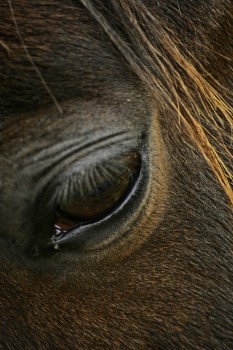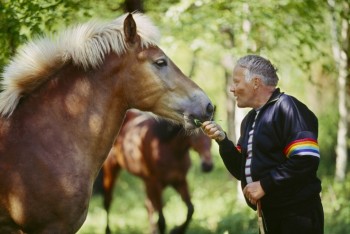Horse sense
2 February 2012 | Essays, Non-fiction

The eye that sees. Photo: Rauno Koitermaa
In this essay Katri Mehto ponders the enigma of the horse: it is an animal that will consent to serve humans, but is there something else about it that we should know?
A person should meet at least one horse a week to understand something. Dogs help, too, but they have a tendency to lose their essence through constant fussing. People who work with horses often also have a dog or two in tow. They patter around the edge of the riding track sniffing at the manure while their master or mistress on the horse draws loops and arcs in the sand. That is a person surrounded by loyalty.
But a horse has more characteristics that remind one of a cat. A dog wants to serve people, play with humans – demands it, in fact. With a dog, a person is in a co-dependent relationship, where the dog is constantly asking ‘Are we still US?’
A dog’s self-esteem isn’t threatened by its boundless desire to please – its self-worth is built on humans. If there’s a tiny drop of Wolf still left in a Dog, it’s escaped to the farthest tip of a hair, looking on in disbelief and shame at its fawning kin.
A Horse and a Cat have no desire to serve, but they will consent to it. A cat will accede to humans, but on its own terms, always ready to walk away, to disappear. A horse will defer to a human’s terms, submit quietly and with dignity like an old family retainer. A horse is like a butler, a valet, a maître d’. It takes orders without a word, does what is asked of it, but at the same time knows the secrets of the one it serves thoroughly. If it wanted to, it could demolish it all in a moment. It wears its loyalty, carries it without complaint. It looks a person in the eye and says: ‘I know who you are.’
A horse looks at the world and at humans with the gaze of Christ, with a whole history’s worth of knowledge, and weariness. It carries on its back bouncing little girls and heavily armed soldiers, country boys and conquerors, men and women decked out in colourful coats, skins, silks and tassels, armour creaks, clanks, clunks, rages, rushes, terror, greed, cruelty, pride, love and bravery. Noble causes and debased thoughts. It consents to pull heavy, creaking wagons, gigs, carts, ploughs, and of course guns. It submits to humans’ games and consents to pull death behind it.
The history of humanity lives in the eyes of the Horse. If those eyes were once bright and happy, now they’ve seen too much. The eyes of an old servant.
In every horse, even the most docile, lives a hysteric. And when an out-of-control horse weighing six hundred kilos gets moving, a person learns something. About the laws of physics, if nothing else. But that’s the only thing about a horse that the slightest bit Newtonian.
The horse’s tendency to hysteria is a mystery. Why? Why is it that when a twig cracks on a forest trail or a car drives too close to the riding path, the Horse decides to give up its horseness and become a projectile? When characteristics were handed out to the animals closest to humans, was the Dog given such an abundance of enthusiasm that the extra had to be installed in the Horse, the dignified Horse? Clearly the Cat has no such interest in the dog’s leftovers.

From eye to eye: a Finnhorse and a Finn. Photo: Topi Ikäläinen
Horses stand silent in their paddocks. Then they decide to show passers-by a moment of horsiness. They back up a step, stand up on their hind legs, stretch their front legs in the air, land, shake their heads and manes. And then it’s over.
Like a current that can be turned on and off.
Horsecurrent.
A moment of power.
Passing Nordic walkers look on in admiration, estranged from nature. ‘What a fine animal. Frightening. So terribly big.’
Maybe the hysteria that bubbles up in the Horse from time to time is the price it pays for covering up its true being. Maybe the Horse is acting. Maybe it plays the part of the Bucker, the Bolter, the Obstinate, the village lunatic of the riding arena, so that people won’t see what a Horse really is. God’s spy.
The Horse is God’s spy. All the animals are. But the Dog’s role was exposed long ago – dogs can’t keep secrets. The Cat, for its part, isn’t terribly interested in the subject of its espionage. It’s more devoted to its own quality time. The Horse is a Master Spy. A Horse gets the job done. A Horse is God’s eyes and ears, God’s hooves and withers.
Bridled, and licenced to… carry. The Horse is more than a spy, it’s a double agent. A horse acts like a horse acting like an animal so no one will know it’s a god. A Horse is a human-bearing god watching silently with ancient eyes as a human lifts his gun and shoots it in the forehead.
The horse and its little brother, the donkey, the four-legged sparrow of the south. Maybe Caligula, who named his horse a senator, wasn’t crazy after all. A person should meet at least one horse a week to understand something. There should be a horse in every high school classroom, every local council, every parliament. A horse breathing eight times per minute. A horse whose heart beats twenty-five times per minute. In a world whose pulse takes a person’s very life away.
A horse is watching me from the paddock, still as a statue. It looks me right in the eye and pricks up its ears. It knows I’m talking about it. It lifts the base of its tail and calmly shits. We all have to stick to our roles.
Translated by Lola Rogers
This essay was published in the book Hevosvoimat (‘Horse powers’, edited by Kirsti Manninen, Maahenki, 2011). This illustrated volume contains 31 of the best contributions to a writing competition organised by Maaseudun Sivistysliitto, the agricultural museum Sarka and the newspaper Maaseudun Tulevaisuus in 2011. The horse – first and foremost, the cold-blooded Finnhorse – has played an important role in the Finnish history, both in the agriculture and in the war, and later the horse has gained popularity as a trusted companion to families and young people, girls in particular
Tags: animals
No comments for this entry yet
